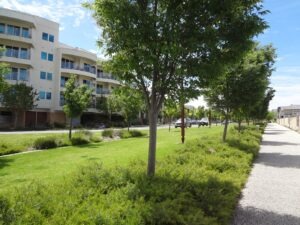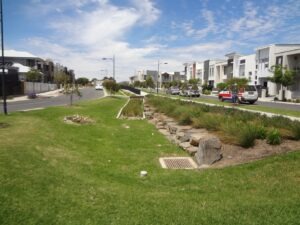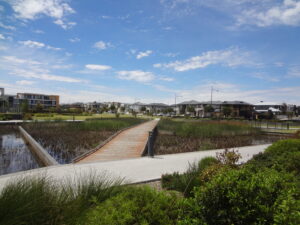
Redward Avenue, Lightsview
In late 2018, the highly anticipated draft Planning and Design Code, under the Planning, Development and Infrastructure Act 2016, is set to be released and will frame the way our communities grow into the future. This whole scale review of the planning system is the best opportunity in 20 years to embed green infrastructure and water sensitive urban design outcomes into policy, to create the type of communities we want to live in.
We are constantly challenged by debate over whether onsite or offsite solutions for green infrastructure and WSUD are best. Well the answer is both, depending on the context. A street with narrow road carriageway and verges provides limited opportunity for offsite solutions and hence a solution on-site would preserve or enhance the amenity of the local streetscape. However, sites that have a wider verge or a carriageway can potentially be reimagined to incorporate green infrastructure and WSUD – transforming our grey infrastructure into attractive green spaces. Precinct scale solutions may offer the most cost-effective solutions for stormwater quality management, if suitable greenspace is available.

City View Boulevard, Lightsview – stormwater harvesting and re-use

Africaine Avenue, Lightsview – raingardens and detention basin

Waterford Circuit,
Lightsview – wetland
The Lightsview development, with a dwelling yield of 35 dwellings per hectare, a gross housing density (in the mid-range of the medium density development spectrum) is balanced by public open space that will constitute 15.7% of the site at full development. It is the streetscapes sustained by recycled stormwater that currently sets Lightsview apart from other developments in Adelaide. Verges of generous proportions offer space for shared paths and deep soil zones that will allow street trees to reach their full height and canopy cover potential. The sustainable recycled stormwater supply sourced from Salisbury Water has supported the establishment of a vast network of healthy street trees surrounded by grassy verges, mitigating the urban heat impacts to great effect.
Treated stormwater, or reWater as it is referred to by the developer, is piped to each household and plumbed internally to toilets and for outdoor uses, including garden irrigation and car washing. A rewater connection from each allotment to the verge irrigates street trees. In many cases the street tree is the only substantial green space in close proximity to the allotment. If Redward Avenue (pictured in our feature image) is any indication of how effective this model for urban infill is, there is signifianct potential for replication elsewhere across our city and regional communities.
To find out more about the WSUD features of the Lightsview development, visit our case study.





